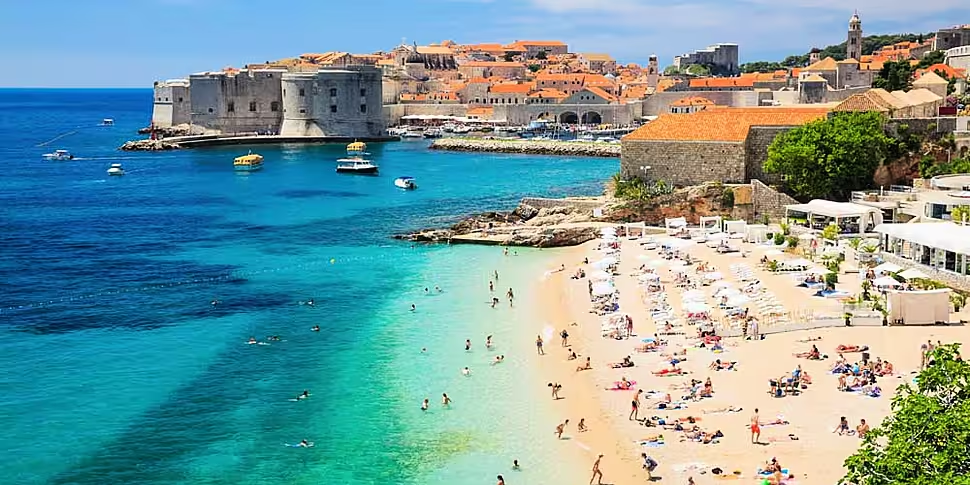Fionn Davenport joined Kieran Cuddihy on the Hard Shoulder another episode of Europe’s Hidden Highlights, this week he visits the Dalmatian coast of Croatia.
Getting There
Aer Lingus (aerlingus.com) flies into Dubrovnik in the south and Pula in the north.
Ryanair (Ryanair.com) flies into Zadar, south of Pula about halfway down the coast.
Getting Around
There’s an excellent bus network all along the coast – Split to Dubrovnik in 3 hours, Zadar to Split in two, etc – but Jadrolinea runs hydrofoil, catamaran and ferry services all along the coast, linking the main towns with the islands.
Accommodation
The main tourist centres are pretty expensive – especially Hvar and Dubrovnik. Split less so, but if you go elsewhere along the coast or to lesser known islands, the prices come down again. I opted for Airbnb, which gave me great choices in a multitude of price brackets.
Split
Croatia's second-largest city, Split (Spalato in Italian) is a great place to see Dalmatian life as it’s really lived. Always buzzing, this exuberant city has just the right balance of tradition and modernity. Step inside Diocletian’s Palace (a Unesco World Heritage site and one of the world’s most impressive Roman monuments) and you’ll see dozens of bars, restaurants and shops thriving amid the atmospheric old walls where Split life has been humming along for thousands of years.
To top it off, Split has a unique setting. Its dramatic coastal mountains act as the perfect backdrop to the turquoise waters of the Adriatic and help divert attention from the dozens of shabby high-rise apartment blocks that fill its suburbs. It's this thoroughly lived-in aspect of Split that means it will never be a fantasy land like Dubrovnik, but you could argue that it's all the better for that.
Accommodation: As you'd expect in a big city that is also a tourist hub, prices in Split tend to be higher than the average - but not as high as the likes of Dubrovnik or Hvar. That said, Split has a good range of hostels and some excellent apartment-style providers catering to the midrange market.
Trogir
Gorgeous Trogir is set within medieval walls on a tiny island, linked by bridges to both the mainland and to the far larger Čiovo island. On summer nights everyone gravitates to the wide seaside promenade, lined with bars, cafes and yachts - leaving the knotted mazelike marble streets gleaming mysteriously under old-fashioned streetlights.
The old town has retained many intact and beautiful buildings from its age of glory, between the 13th and 15th centuries. In 1997 its profuse collection of Romanesque and Renaissance buildings earned it World Heritage status.
While it's easily reached on a day-trip from Split, Trogir also makes a good alternative base to the big city and a relaxing place to spend a few days.
Brač
Brač is famous for two things: its radiant white stone, from which Diocletian’s Palace in Split and the White House in Washington DC (oh, yes!) are made, and Zlatni Rat, the long pebbly beach at Bol that extends lasciviously into the Adriatic and adorns 90% of Croatia’s tourism posters. It’s the largest island in central Dalmatia, with several towns and sleepy villages and a dramatic Mediterranean landscape of steep cliffs, inky waters and pine forests. The interior of the island is liberally scattered with piles of rocks – the result of the back-breaking labour of women who, over hundreds of years, gathered the rocks in order to clear land for the cultivation of vineyards and olive, fig, almond and sour-cherry orchards.
The tough living conditions on the island meant that a lot of people moved to the mainland in search of work, leaving the interior almost deserted. Driving around and exploring Brač’s stone villages is one of the island's loveliest experiences.
The two main centres, Supetar and Bol, differ greatly from one another: Supetar is a pleasant if unassuming place, while Bol revels in its more exclusive appeal.
Zlatni Rat – highly overrated. It looks great – from a helicopter. Otherwise it’s just another packed pebbly beach. There are far nicer beaches on the other side of Bol – but to really get the experience rent a motorboat and go along the island’s southwestern shores to find your own cove and pebbly beach.
Dubrovnik
Undoubtedly beautiful and worth the effort – up to a point.
Today Dubrovnik is the most prosperous, elegant and expensive city in Croatia. In many ways it still feels like a city state, isolated from the rest of the nation by geography and history. It’s become such a tourism magnet that there’s even talk of having to limit visitor numbers in the car-free old town – the main thoroughfares can get impossibly crowded, especially when multiple cruise ships disgorge people at the same time.
The Old Town – everybody goes for the walk along the city walls – 1.9km around the city. And it’s beautiful. No visit to Dubrovnik would be complete without a walk around the spectacular city walls, the finest in the world and the city's main claim to fame. From the top, the view over the old town and the shimmering Adriatic is sublime. You can get a good handle on the extent of the shelling damage in the 1990s by gazing over the rooftops: those sporting bright new terracotta suffered damage and had to be replaced.
Staying
I would strongly recommend Lapad – away from the bustle of the old town, but easily reached – there’s a terrific bus system in Dubrovnik.
Eating
The Old Town isn’t the place to eat; go to Lapad
Restaurant Levanat – on the north side of Lapad Bay, is the best spot we ate in during the whole trip – amazing Mediterranean cuisine with stunning views of the bay. Best sunsets in Europe, I reckon! To get there, walk the length of the pedestrianized Setaliste Kralja Zvonimira, which is itself lined with bars and restaurants and…just keep going for about 1km along the coastline path.
Game of Thrones
Dubrovnik is like a fantasy world for most people, but fans of Game of Thrones have more reason to indulge in flights of fancy than most, as a large chunk of the immensely popular TV series was filmed here. While Split and Šibenik were also used as locations, Dubrovnik has featured the most prominently, standing in for the cities of King's Landing and Qarth. If you fancy taking your own Walk of Shame through the streets of Westeros, here are some key spots:
- Fort St Lawrence King's Landing's famous Red Keep. Cersei farewelled her daughter Myrcella from the little harbour beneath it.
- City Walls Tyrion Lannister commanded the defense of King's Landing from the seaward-facing walls during the Battle of the Blackwater;
- Minčeta Tower The exterior of Qarth's House of Undying;
- Rector's Palace The atrium featured as the palace of the Spice King of Qarth - they didn't even bother moving the statue!;
- Sv Dominika street The street and staircase outside the Dominican Monastery were used for various King's Landing market scenes.
- Uz Jezuite The stairs connecting the Jesuit church to Gundulić Square were the starting point for Cersei Lannister's memorable naked penitential walk. The walk continued down Stradun.
- Gradac Park The site of the Purple Wedding feast, where King Joffrey finally got his comeuppance.
- Ethnographic Museum Littlefinger's brothel;
- Lokrum The reception for Daenerys in Qarth was held in the monastery cloister;
- Trsteno Arboretum The Red Keep gardens, where the Tyrell's chatted and plotted endlessly during seasons three and four.
Korčula Town (on the island of the same name) is a stunner. Ringed by imposing defences, this coastal citadel is dripping with history, with marble streets rich in Renaissance and Gothic architecture.
Its fascinating fishbone layout was cleverly designed for the comfort and safety of its inhabitants: western streets were built straight in order to open the city to the refreshing summer maestral (strong, steady westerly wind), while the eastern streets were curved to minimise the force of the winter bura (cold, northeasterly wind).
The town cradles a harbour, overlooked by round defensive towers and a compact cluster of red-roofed houses. There are rustling palms all around and several beaches are an easy walk away.
Mljet
Forest-shrouded Mljet is one of the most seductive of all the Adriatic islands. The establishment of a national park in 1960 at its western end put the island on the tourist map, but Mljet is anything but overrun. Visitors are almost entirely drawn to the tourist enclave around Pomena. The remainder of the island retains the unspoilt air of tranquillity that, according to legend, captivated Odysseus for seven years.
Ston
Flanking the isthmus that connects the Pelješac Peninsula with the mainland, Ston and Mali ('little') Ston – are famous for three things: salt, oysters and the remarkable 5.5km defensive wall that links them.
The first two have been harvested here since Roman times. The name Ston derives from its Latin name Stagnum, a reference to the marshy nature of the land, which was put to use for the production of salt. The economic importance of this industry to the Republic of Ragusa (Dubrovnik) led, in 1333, to the construction of one of the longest fortifications in Europe, stretching clear across the isthmus.
Within its walls, Ston has an atmospheric medieval town centre with sunny, car-free streets. Mali Ston is a gastronomic destination in its own right, famed for the mussels and large flat oysters that thrive in the narrow channel separating the peninsula from the mainland.











